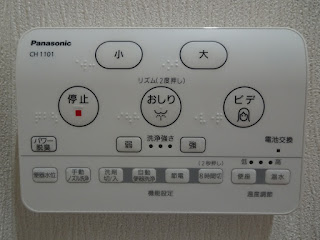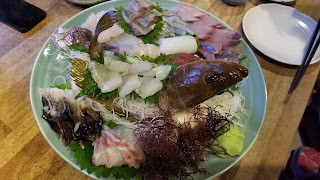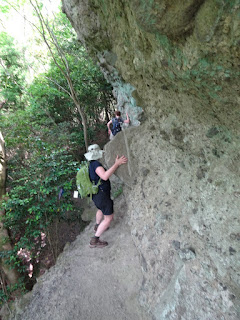 |
| Small, but we wouldn't want to drive it on narrow Japanese roads |
Not everything we experienced or observed in Japan fits into the narrative of the day. Some topics need their own mini blog or at least a photo. So here are a few things we found interesting during our three-and-a-half week trip there.
Small
Everything in Japan seemed small to us, and we're not big people. Cars, RVs, hotel rooms--you name it--they seemed small to us. What wasn't small? Our meals. While the individual tidbits of food were small, they were numerous, making for huge meals. And the ramen bowls were more than we could eat.
 |
| More arrived after this photo. (You can see more Japanese food porn by clicking on the link at the bottom) |
Ubiquitous and smart vending machines
 |
| Vending machines at the Golden Pavillion in Kyoto |
Cleanliness
Other than Singapore, Japan is probably the cleanest country we've ever experienced, including the US. Litter is nonexistent, but so are trash cans. Everyone is expected to keep their trash with them and dispose of it at home. But cleanliness goes beyond litter. One doesn't wear shoes inside a home and is expected to use special slippers when using the bathroom. You shower before you soak in the tub.
 |
| The bathing stools, buckets, and showers before entering the soaking tub |
 |
| Regular and bathroom slippers |
Toilets
No discussion of cleanliness or Japan would be complete without mentioning toilets. We miss them so much! The hotels, inns, convenience stores, train stations, and some rest stops have high tech bidet toilets, with male and female settings, where the pressure and water temperature can be adjusted. (Jokes can be made here, but I'll refrain.) Many have heated seats and some have blow dryers! It took awhile to figure them out because there were no instructions in english. The women toilets in public places often start making loud water trickle sounds as soon as one enters the stall, as Japanese women feel embarrassed by the sound of their own peeing.
 |
| Wall mounted toilet instructions. Can you guess which bidet button is for men or women? Which one flushes? |
We found the custom of bowing amusing and pervasive. And the same goes for the vigorous waving-goodbye sessions by our hosts until we are out of sight. We were greeted at the inns with a bow. The cashiers bow and accept our money with both hands. People bow to one another in the elevators and on the trail. I thought it was classy when the train conductor bowed deeply to all the passengers as he left the car, exiting backward through a sliding door. But the winning bow award goes to the two airport workers with the big flashlights directing our plane in Tokyo out of the gate and onto the tarmac. After our plane was pointed in the right direction, they waited for it to start moving, holstered their lights, took a deep bow, and vigorously waved goodbye with both hands until we couldn't see them anymore!
 |
| At the Kyoto RR & Subway Guilt Emporium |
Gifts
Every train station, airport, and subway shopping mall has what we call "Guilt Stores" or "Obligation Emporiums." Gift giving is important for every occasion, special or not. Since most people live in very small houses and apartments, beautifully packaged food items are a big hit. The boxes contain elaborate pastries, seaweed, cakes, saki, whiskey, crackers, raw sashimi, and more. With more samples than Costco on a Saturday, it was a fun way to snack and drink.
 |
| Outside our Inn on Miyajima Island |
Food Displays
Most of the menus where we ate didn't have English in them. But rest assured, we ate well. Many of the restaurants in tourist areas had elaborate plastic models of what they served. It's quite an art form. We may not have known that we were about to eat raw pickled fish eggs, but at least we knew what they looked like. Going through convenience and grocery stores was a blast. So many snacks to try! Some were delightful, some were forgettable. You never knew until you bought the bag and tasted the contents.
 |
| This deer knew how to work the sliding doors to our inn at Miyajima Island |
Sliding doors
Other than doors to rooms in western-style hotels, nearly every door we encountered was a shoji screen or a sliding door. Many were automatic and fast, like on the Starship Enterprise or on the Shinkansen (the bullet train). But some weren't, or they opened too slowly, creating some confusion and an occasional collision with one.
Cell Phones and Selfie Sticks
 |
| Seen in train stations and tourist areas |
Speaking of collisions, more than once we bumped into clueless cell phone addicts on busy streets or subway stations. It seemed like everyone had one and used it constantly--but not for talking. In fact, phone conversations are not allowed or at least discouraged on railway and subway cars and busses. We traveled with an international wifi hotspot and used phones for downloaded maps from Maps.me and Google Translate. (It was great when it worked, and humorous when it didn't!)
Most train stations and many of the more popular tourist sites now prohibit selfie sticks. (YES!) Too many people trying to star in their "It's all about me" movies were creating hazards, blocking views for other photographers, and holding up the flow of the large crowds.
Background and wake-up music
It seemed like every noodle shop and sushi bar in which dined played jazz, mostly smooth jazz. There must be something about ramen that brings out the inner Miles Davis. Our roykans (traditional Japanese inns), were a different genre altogether. We were often awakened at 6:00 am to a music box rendition of Edelweiss. The loudspeakers in small villages or temple areas also played Bavarian chime music at noon.
"Feeding the bird"
A lot of places didn't accept credit cards, so cash was king. The bills were easy to understand, but the coins were complicated. So when making a small purchase requiring change, we simply held out a handful of coins. The clerk would pick away at them to get what was needed. Honesty was never a problem. We had one clerk chase us down a half block because we had overpaid by a few cents.
Purse Baskets
And speaking of honesty, we saw women leave their purses on tables in coffee shops to go place their orders. They weren't worried, nor did they need to be. Since eating and drinking establishments were small and crowded, most of them had baskets under the tables for one's purses, backpack or umbrella.
"Feeding the bird"
 |
| Typical purse/bag basket |
Purse Baskets
And speaking of honesty, we saw women leave their purses on tables in coffee shops to go place their orders. They weren't worried, nor did they need to be. Since eating and drinking establishments were small and crowded, most of them had baskets under the tables for one's purses, backpack or umbrella.
But wait, there's more....
We could go on, but we won't. Let's just close with saying it is a wonderful and unique place to visit. The people, while not outgoing, are unbelievably helpful and courteous. They stand in neat lines and obey the crosswalk signals. It's clean and modern. You can drink the water. It's efficient, down to the minute. The food is fantastic if you're not squeamish. The countryside is beautiful. The onsens (hot baths) are so civilized! Many of the signs have English lettering at the bottom, and the major trains have English announcements. Tipping isn't expected, so that brings down the cost of meals and services. Oh, and don't forget the toilets! We'll be back!
 |
| Some of the tableware for our final feast in a family-owned ryokan in Kagoshima |
Click here if you're into Japanese food porn.
Click here for a "few" photos that hopefully captures the essence of our trip.




















































